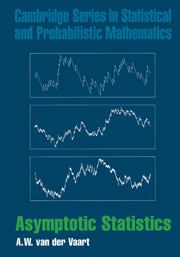Book contents
- Frontmatter
- Dedication
- Contents
- Preface
- Notation
- 1 Introduction
- 2 Stochastic Convergence
- 3 Delta Method
- 4 Moment Estimators
- 5 M–and Z-Estimators
- 6 Contiguity
- 7 Local Asymptotic Normality
- 8 Efficiency of Estimators
- 9 Limits of Experiments
- 10 Bayes Procedures
- 11 Projections
- 12 U -Statistics
- 13 Rank, Sign, and Permutation Statistics
- 14 Relative Efficiency of Tests
- 15 Efficiency of Tests
- 16 Likelihood Ratio Tests
- 17 Chi-Square Tests
- 18 Stochastic Convergence in Metric Spaces
- 19 Empirical Processes
- 20 Functional Delta Method
- 21 Quantiles and Order Statistics
- 22 L-Statistics
- 23 Bootstrap
- 24 Nonparametric Density Estimation
- 25 Semiparametric Models
- References
- Index
17 - Chi-Square Tests
Published online by Cambridge University Press: 05 June 2012
- Frontmatter
- Dedication
- Contents
- Preface
- Notation
- 1 Introduction
- 2 Stochastic Convergence
- 3 Delta Method
- 4 Moment Estimators
- 5 M–and Z-Estimators
- 6 Contiguity
- 7 Local Asymptotic Normality
- 8 Efficiency of Estimators
- 9 Limits of Experiments
- 10 Bayes Procedures
- 11 Projections
- 12 U -Statistics
- 13 Rank, Sign, and Permutation Statistics
- 14 Relative Efficiency of Tests
- 15 Efficiency of Tests
- 16 Likelihood Ratio Tests
- 17 Chi-Square Tests
- 18 Stochastic Convergence in Metric Spaces
- 19 Empirical Processes
- 20 Functional Delta Method
- 21 Quantiles and Order Statistics
- 22 L-Statistics
- 23 Bootstrap
- 24 Nonparametric Density Estimation
- 25 Semiparametric Models
- References
- Index
Summary
The chi-square statistic For testing hypotheses concerning multinomial distributions derives its name From the asymptotic approximation to its distribution. Two important applications are the testing of independence in a two-way classification and the testing of goodness-of-fit. In the second application the multinomial distribution is created artificially by grouping the data, and the asymptotic chi-square approximation may be lost if the original data are used to estimate nuisance parameters.
Quadratic Forms in Normal Vectors
The chi-square distribution with k degrees of freedom is (by definition) the distribution of for i.i.d. N(O, 1)-distributed variables, The sum of squares is the squared norm of the standard normal vector. The following lemma gives a characterization of the distribution of the norm of a general zero-mean normal vector.
17.1 Lemma. If the vector X is Nk-distributed, then is distributed as, the eigenvalues.
Proof. There exists an orthogonal matrix such that. Then the vector is diag -distributed, which is the same as the distribution of the vector has the same distribution.
The distribution of a quadratic form of the type is complicated in general. However, in the case that every is either, it reduces to a chi-square distribution. If this is not naturally the case in an application, then a statistic is often transformed to achieve this desirable situation. The definition of the Pearson statistic illustrates this.
Pearson Statistic
Suppose that we observe a vector with the multinomial distribution corresponding to trials and classes having probabilities. The Pearson statistic for testing the null hypothesis is given by
We shall show that the sequence converges in distribution to a chi-square distribution if the null hypothesis is true. The practical relevance is that we can use the chi-square table to find critical values for the test.
Information
- Type
- Chapter
- Information
- Asymptotic Statistics , pp. 242 - 254Publisher: Cambridge University PressPrint publication year: 1998
